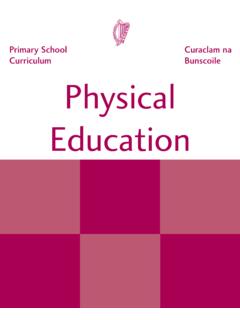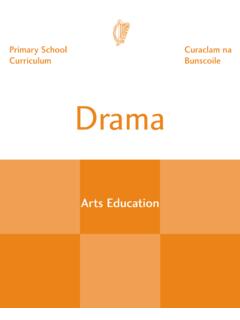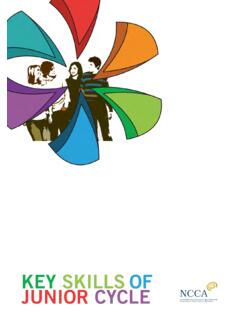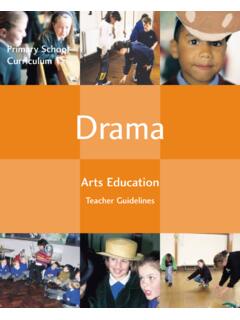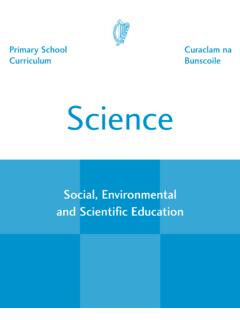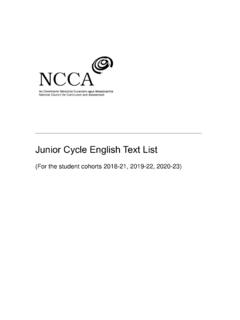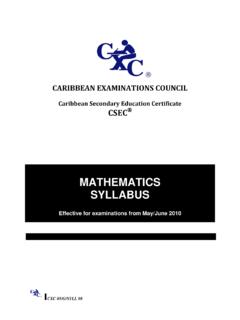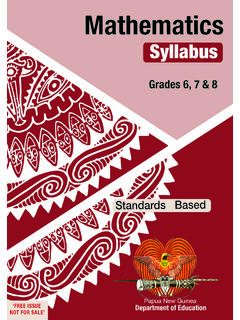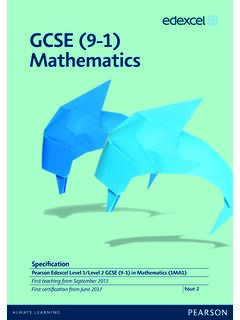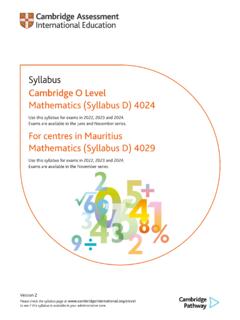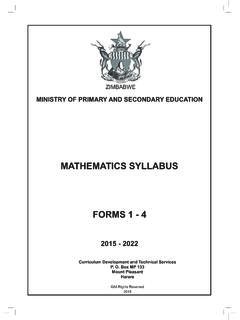Transcription of MATHEMATICS - Curriculum
1 An Roinn Oideachais agus ScileannaMatheMaticssyllabusFOuNDatiON, ORDiNaRy & hiGheR leVelFor examination from 2015leaViNGceRtiFicate 3 Leaving Certificate Mathematicssection aMathematics 5 Introduction and rationale 6 Aim 6 Objectives 6 Related learning 7 syllabus overview 8 Structure 8 Key skills 9 Problem solving 10 Teaching and learning 10 Differentiation
2 11 strands of study 13 Strand 1: Statistics and Probability 15 Strand 2: Geometry and Trigonometry 23 Strand 3: Number 27 Strand 4: Algebra 35 Strand 5: Functions 41assessment 44appendix: trigonometric formulae 45section b Geometry for Post-primary school MATHEMATICS 47 Leaving Certificate Mathematics4 5 Leaving Certificate MathematicsMatheMatics Leaving Certificate Mathematics6introduction and rationaleMathematics is a wide-ranging subject with many aspects.
3 Most people are familiar with the fact that MATHEMATICS is an intellectual discipline that deals with abstractions, logical arguments, deduction and calculation. But MATHEMATICS is also an expression of the human mind reflecting the active will, the contemplative reason and the desire for aesthetic perfection. It is also about pattern, the MATHEMATICS of which can be used to explain and control natural happenings and situations. Increasingly, MATHEMATICS is the key to opportunity. No longer simply the language of science, MATHEMATICS contributes in direct and fundamental ways to business, finance, health and defence. For students it opens doors to careers.
4 For citizens it enables informed decisions. For nations it provides knowledge to compete in a technological community. Participating fully in the world of the future involves tapping into the power of MATHEMATICS . Mathematical knowledge and skills are held in high esteem and are seen to have a significant role to play in the development of the knowledge society and the culture of enterprise and innovation associated with it. MATHEMATICS education should be appropriate to the abilities, needs and interests of learners and should reflect the broad nature of the subject and its potential for enhancing their development. The elementary aspects of MATHEMATICS , use of arithmetic and the display of information by means of a graph are an everyday occurrence.
5 Advanced MATHEMATICS is also widely used, but often in an unseen and unadvertised way. The MATHEMATICS of error-correcting codes is applied to CD players and to computers. The stunning pictures of far away planets and nebulae sent by Voyager II and Hubble could not have had their crispness and quality without such MATHEMATICS . In fact, Voyager s journey to the planets could not have been planned without the MATHEMATICS of differential equations. In ecology, MATHEMATICS is used when studying the laws of population change. Statistics not only provides the theory and methodology for the analysis of wide varieties of data but is essential in medicine, for analysing data on the causes of illness and on the utility of new drugs.
6 Travel by aeroplane would not be possible without the MATHEMATICS of airflow and of control systems. Body scanners are the expression of subtle MATHEMATICS discovered in the 19th century, which makes it possible to construct an image of the inside of an object from information on a number of single X-ray views of it. Thus, MATHEMATICS is often involved in matters of life and Certificate MATHEMATICS aims to develop mathematical knowledge, skills and understanding needed for continuing education , life and work. By teaching MATHEMATICS in contexts that allow learners to see connections within MATHEMATICS , between MATHEMATICS and other subjects, and between MATHEMATICS and its applications to real life, it is envisaged that learners will develop a flexible, disciplined way of thinking and the enthusiasm to search for creative objectives of Leaving Certificate MATHEMATICS are that learners develop mathematical proficiency, characterised as conceptual understanding comprehension of mathematical concepts, operations, and relations procedural fluency skill in carrying out procedures flexibly, accurately, efficiently.
7 And appropriately strategic competence ability to formulate, represent, and solve mathematical problems in both familiar and unfamiliar contexts adaptive reasoning capacity for logical thought, reflection, explanation, justification and communication productive disposition habitual inclination to see MATHEMATICS as sensible, useful, and worthwhile, coupled with a belief in diligence, perseverance and one s own certificate MATHEMATICS 7 Leaving Certificate MathematicsRelated learningEarly childhoodJUNior cyclESENior cyclEcoMMUNiTy aNd SociETyPriMary SchoolFUrThEr lEarNiNGThe way in which MATHEMATICS learnt at different stages links together is very important to the overall development of mathematical understanding.
8 The study of Leaving Certificate MATHEMATICS encourages learners to use the numeracy and problem solving skills developed in early childhood education , primary MATHEMATICS and junior cycle MATHEMATICS . The emphasis is on building connected and integrated mathematical understanding. As learners progress through their education , mathematical skills, concepts and knowledge are developed when they work in more demanding contexts and develop more sophisticated approaches to problem solving. In this way mathematical learning is cumulative, with work at each level building on and deepening what students have learned at the previous is not learned in isolation; it has significant connections with other Curriculum subjects.
9 Many science subjects are quantitative in nature and learners are expected to be able to work with data, produce graphs and interpret patterns and trends. Design and Communication Graphics uses drawings in the analysis and solution of two- and three-dimensional problems through the rigorous application of geometric principles. In Geography learners use ratio to determine scale. Every day, people use timetables, clocks and currency conversions to make life easier. Consumers need basic financial awareness and in Home Economics learners use MATHEMATICS when budgeting and making value for money judgements. Learners use MATHEMATICS in Economics for describing human behaviour.
10 In Business Studies learners see how MATHEMATICS can be used by business organisations in accounting, marketing, inventory management, sales forecasting and financial analysis. MATHEMATICS , Music and Art have a long historical relationship. As early as the fifth century , Pythagoras uncovered mathematical relationships in music, while many works of art are rich in mathematical structure. The modern MATHEMATICS of fractal geometry continues to inform composers and artists. MATHEMATICS sharpens critical thinking skills, and by empowering learners to critically evaluate information and knowledge it promotes their development as statistically aware consumers.
